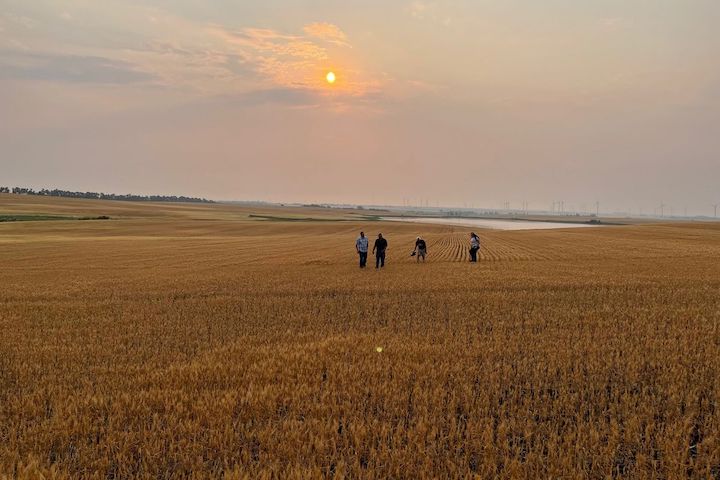US heat is so bad farmers see a ‘half crop’ for spring wheat
Sun-baked U.S. spring wheat fields have been so badly hurt by drought this year that some farmers are expecting to harvest what they’re dubbing a “half a crop.”
Plants are visibly stunted. So much so that when crop scouts toured the fields of top-producing state North Dakota this week they kept having to get close to the ground to inspect crops that were about 10 inches (25 centimeters) or shorter—about a third of the normal size for this time of year. Large patches of dry soil could be seen in between rows. In better seasons, the ground isn’t even visible.
All told, the harsh conditions will send yields for spring wheat in the state plunging to 29.1 bushels an acre this year, according to final assessment of estimates following the Wheat Quality Council’s crop tour. While that’s slightly higher than the most-recent estimate from the U.S. Department of Agriculture, it would still mean a drop of 41% from last year’s harvest.

Spring wheat is highly prized worldwide for giving foods like pizza crust and bagels their chewiness. This season’s expected shortfall hits as neighboring Canada contends with extreme heat and dryness as well, putting those crops at risk. North American baking and milling companies may end up having to look overseas for imports. Some farmers, after battling shriveled crops and damaging grasshoppers, have already opted to bale up plants for hay or consider the entire field a loss.
“When we only have half a crop this year, there is going to have to be rationing on those bushels,” said Philip Volk, a farmer who also serves as chairman for the North Dakota Wheat Commission, adding that will especially squeeze the countries that rely on American exports.
Yields for the durum wheat variety, used for high-end yellow pasta, are seen plummeting 38%, according to crop tour estimates.
Volk and other tour participants stressed that the quality of wheat set to be harvested looks strong and should have higher-than-average protein. That’s good news for food processors given that this season’s winter wheat harvest, while abundant, was lacking in protein.
Still, pricing will be a concern with spring wheat futures surging to recent eight-year highs and up more than 50% since January.
“Typically, millers would like to use more spring wheat but if prices are prohibitive they will have to figure out other ways,” said Rich Kendrick, vice president of business development at Kansas-based Great Plains Analytical Laboratory, which tests grain and flour for large milling companies and bakeries.
Similar Stories

December 2024 U.S. Transportation Sector Unemployment (4.3%) Was the Same As the December 2023 Level (4.3%) And Above the Pre-Pandemic December 2019 Level (2.8%)
View ArticleDP World appoints Jason Haith as Vice President of Freight Forwarding for U.S. and Mexico
DP World, a global leader in logistics and supply chain solutions, has announced the appointment of Jason Haith as Vice President, Commercial Freight Forwarding – U.S. and Mexico, effective immediately.…
View Article
Amaero secures final approval for $23.5M loan from Export-Import Bank
View ArticleU.S. Bureau of Labor Statistics employment situation
Total nonfarm payroll employment increased by 256,000 in December, and the unemployment rate changed little at 4.1 percent, the U.S. Bureau of Labor Statistics reported today. Employment trended up in…
View ArticleImport Cargo to remain elevated in January
A potential strike at East Coast and Gulf Coast ports has been avoided with the announcement of a tentative labor agreement, but the nation’s major container ports have already seen…
View ArticleS&P Global: 2025 U.S. transportation infrastructure sector should see generally steady demand and growth
S&P Global Ratings today said it expects activity in the U.S. transportation sector will continue to normalize in 2025, with growth rates for most modes of transportation slowing to levels…
View ArticleGet the most up-to-date trending news!
SubscribeIndustry updates and weekly newsletter direct to your inbox!





